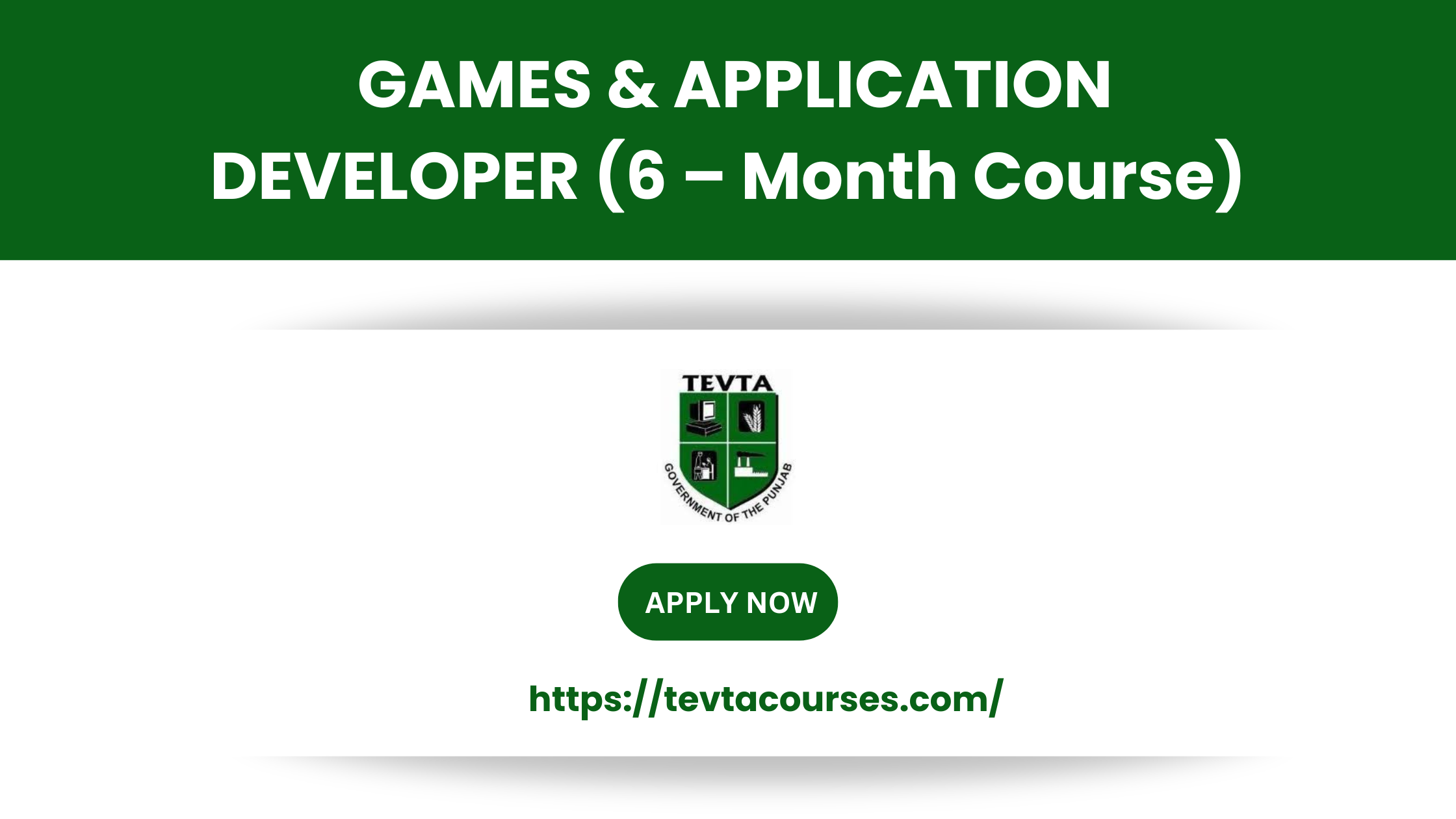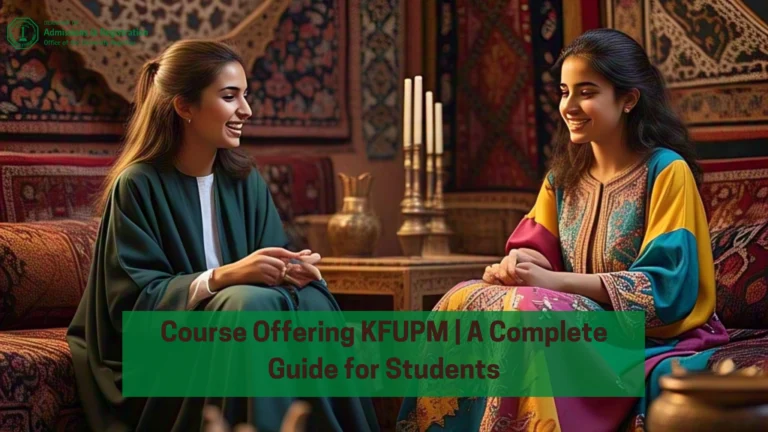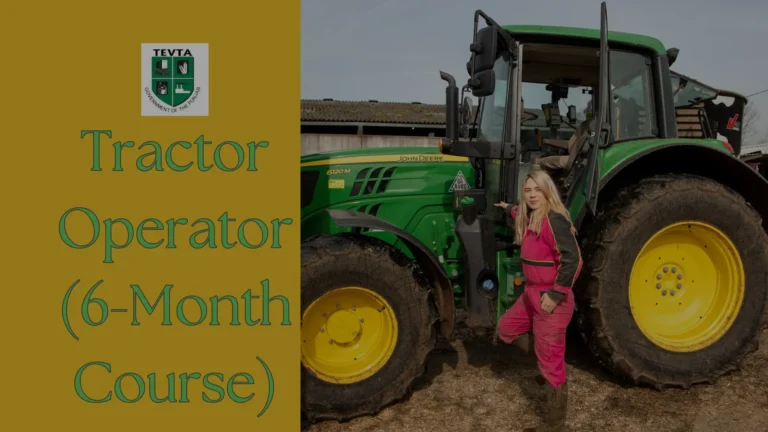GAMES & APPLICATION DEVELOPER (6 – Month Course)
Tevta courses offered GAMES & APPLICATION DEVELOPER (6 – Month Course).TEVTA educates students who are unable to get admission to prestigious universities due to several reasons such as low marks, unaffordable degree programs, or any other situation but wish to have a successful career and aspire for professional life.
TEVTA believes that the core objective of training is passing on information, knowledge, and industry experience to cover the gap between academia and professionals. Hands-on training methods are designed and practiced by professional trainers.
TEVTA pioneers along with the existing conventional chalk-talk methods and encourages innovation to ultimately serve the attainment of the core objective of teaching. The use of computers, tools, and blended methods of best practices in the classroom environment will create the real effect of a software house.
Such an innovative environment created by TEVTA trainers within the classroom and such effective use of technology and industry professionals will facilitate as instructors the way to the growth of student’s capacity, adaptability, rationality, and intellectual abilities along with a smart approach for reasoning and drawing conclusions. Skillset enhancement activities will nurture students’ personalities as well.
Also see: Minister launches five language courses in TEVTA 2024 / New Update
Details About GAMES & APPLICATION DEVELOPER (6 – Month Course)
- Name of Course: Application & Games Developer
- Entry Requirements: F.Sc. / ICS Students or Equivalent
- Duration of course: 6 months
- Total Training Hours: 800
- Training Methodology: Practical 80%, Theory 20%
- Medium of Instruction: English / Urdu
SKILL PROFICIENCY DETAILS
Upon successful completion of this course, the trainee should be able to:
- Demonstrate and communicate an Overview of Computer Games
- Perform work as per the Object-Oriented Programming (OOP) Paradigm
- Have basic hands-on knowledge of programming languages
- Perform hands-on game development in the future of the gaming industry as well
- Define and explain theoretical and practical instructions about the basic Gaming Philosophy
- Apply hands-on relevant Gaming Project Management
- Produce practical & relevant Gaming Project Documentation
- Perform effective and efficient hands-on work with the C# language
- Define basic and practical Java concepts
- Describe the basic concept of gaming Artificial Intelligence (AI)
- Perform hands-on efficient work in Graphics Designing
- Describe basic concepts of 3D Modeling and examples
- Describe basic animation concepts and examples
- Practically perform & describe about Cross-Platform Tools
- Practically demonstrate the closing, in a game project
KNOWLEDGE PROFICIENCY DETAILS
On successful completion of this course, the trainee should be able to:
1) Game Development
I. Define all game development cycle’s problems and issues II. Perform the story creation steps, selection of programming language, analysis, graphics, basic artificial intelligence, and others related to games. III. Define and adopt game development as a career for their secured future.
2) Mobile Application Development
I. Describe the whole life cycle of Mobile Application Development II. Explain the total mechanism and making of applications that are used to perform specific tasks through gizmo, for instance, Health App, Locations App, Commercial Store Finders, Fitness Exercises, and so on.
3) Software Development
I. Explain the overall software development lifecycle (SDLC) II. Know the process of computer programming, documenting, testing, and bug fixing (debugging) III. Know comprehensive knowledge of creating and performing maintenance of an application and produce various other software products. IV. Even perform desktop software development, and want to adopt it as a profession, this course will be an absolutely fabulous kick start.
SCHEME OF STUDIES
Games & Application Developer (6-Months)
| Sr. No | Main Topics | Theory Hours | Practical Hours | Total Hours |
|---|---|---|---|---|
| 1 | Fundamentals of Course | 83 | 319 | 402 |
| 2 | Requirement Elicitation | 15 | 78 | 93 |
| 3 | Game Design | 18 | 73 | 91 |
| 4 | Game Development | 21 | 103 | 124 |
| 5 | Delivery | 4 | 21 | 25 |
| 6 | Work Ethics (Soft Skills) | 19 | 46 | 65 |
| Grand Total | 160 | 640 | 800 |
Also see: Big News TEVTA Online Courses Offering 2024 | TEVTA Online Short Course List
DETAIL OF COURSE CONTENTS
Application & Games Developer (6-Months)
| S.No | Detail of Contents | Theory | Practical |
|---|---|---|---|
| 1 | FUNDAMENTALS OF COURSE | ||
| 1.1 | Overview of Computer | 2 | 0 |
| 1.2 | Types of Computer | 2 | 0 |
| 1.3 | Input / Output Devices | 2 | 0 |
| 1.4 | Use Of Computer | 1 | 0 |
| 1.5 | Operating Systems | 2 | 0 |
| 1.6 | Internet System | 1 | 0 |
| 1.7 | What is a Class? | 1 | 7 |
| 1.8 | What is an object? | 1 | 7 |
| 1.9 | How to Identify and Design a Class? | 1 | 7 |
| 1.10 | What is Encapsulation for Information hiding? | 1 | 7 |
| 1.11 | What is Association? | 1 | 7 |
| 1.12 | Difference between Association, Aggregation & Composition | 2 | 7 |
| 1.13 | What is Abstraction and Generalization? | 1 | 7 |
| 1.14 | What is an Abstract Class? | 1 | 7 |
| 1.15 | What is an Interface? | 1 | 6 |
| 1.16 | Difference between Interface & Class | 2 | 6 |
| 1.17 | Difference between Interface and Abstract Class | 2 | 6 |
| 1.18 | What is the Implicit and Explicit Interface implementation | 2 | 6 |
| 1.19 | What is inheritance? | 2 | 6 |
| 1.20 | What is Polymorphism? | 2 | 6 |
| 1.21 | What is Method Overloading? | 2 | 6 |
| 1.22 | What is Operator Overloading | 1 | 6 |
| 1.23 | What is Method Overriding? | 1 | 7 |
| 1.24 | What is a Use Case? | 2 | 7 |
| 1.25 | What is a Class Diagram? | 1 | 7 |
| 1.26 | What is a Package Diagram? | 2 | 7 |
| 1.27 | What is a Sequence Diagram? | 1 | 6 |
| 1.28 | What is two-Tier architecture? | 2 | 6 |
| 1.29 | What is Three-Tier Architecture? | 2 | 6 |
| 1.30 | What is MVC Architecture? | 3 | 6 |
| 1.31 | Introduction of JAVA | 1 | 7 |
| 1.32 | Variables | 2 | 7 |
| 1.33 | Control Flow | 2 | 7 |
| 1.34 | Arrays in JAVA | 2 | 7 |
| 1.35 | JAVA Methods | 1 | 7 |
| 1.36 | JAVA Error Handling | 2 | 7 |
| 1.37 | C# Basics | 1 | 7 |
| 1.38 | Conditions in C# | 2 | 7 |
| 1.39 | Loops in C# | 2 | 7 |
| 1.40 | Arrays in C# | 2 | 6 |
| 1.41 | Functions in C-Sharp | 2 | 7 |
| 1.42 | Finding String Length in C# | 1 | 7 |
| 1.43 | Array Sorting in C# | 2 | 6 |
| 1.44 | Creating a Project in Visual Studio | 2 | 7 |
| 1.45 | C# Error Handling | 2 | 6 |
| 1.46 | Basic SQL Queries | 2 | 6 |
| 1.47 | Error Handling in SQL Server | 2 | 6 |
| 1.48 | Data insertion, Update, and Deletion in SQL | 1 | 6 |
| 1.49 | Basic Python | 2 | 7 |
| 1.50 | Variables in Python | 1 | 7 |
| 1.51 | Conditions in Python | 2 | 6 |
| 1.52 | Loops in Python | 1 | 6 |
| 1.53 | Functions in Python | 1 | 6 |
| 1.54 | Error Handling in Python | 1 | 7 |
| 1.55 | Basic HTML | 2 | 7 |
| 1.56 | Basic CSS | 2 | 7 |
| 1.57 | Creating a Simple Game in C# | 2 | 7 |
| 1.58 | Final Term Project | 3 | 7 |
| Total Hours: 83 | 83 | 319 |
| S.No | Detail of Contents | Theory | Practical |
|---|---|---|---|
| 2 | REQUIREMENT ELICITATION | ||
| 2.1 | Identifying Stakeholders | 3 | 7 |
| 2.2 | Recognizing Multiple Viewpoints | 3 | 6 |
| 2.3 | Working towards Collaboration | 3 | 6 |
| 2.4 | Sharing Understanding of the Problem | 2 | 7 |
| 2.5 | Avoiding Tunnel Vision | 2 | 6 |
| 2.6 | Confirming Requirements with Stakeholders | 2 | 7 |
| Total Hours: 15 | 15 | 78 |
| S.No | Detail of Contents | Theory | Practical |
|---|---|---|---|
| 3 | GAME DESIGN | ||
| 3.1 | Choosing a Project | 2 | 7 |
| 3.2 | Initial Project Considerations | 3 | 6 |
| 3.3 | Defining the Game | 2 | 7 |
| 3.4 | Defining the Players | 2 | 7 |
| 3.5 | Defining the Gameplay | 2 | 7 |
| 3.6 | Defining the Resources | 2 | 7 |
| 3.7 | Defining the Game’s Art Style | 2 | 7 |
| 3.8 | Working with Technical Staff | 3 | 6 |
| Total Hours: 18 | 18 | 73 |
| S.No | Detail of Contents | Theory | Practical |
|---|---|---|---|
| 4 | GAME DEVELOPMENT | ||
| 4.1 | Programming Game Logic | 2 | 7 |
| 4.2 | Creating Art Assets | 2 | 7 |
| 4.3 | Implementing Sound and Music | 2 | 7 |
| 4.4 | Level Design | 2 | 7 |
| 4.5 | Integrating Game Elements | 2 | 7 |
| 4.6 | Debugging and Testing | 2 | 7 |
| 4.7 | Optimizing Performance | 2 | 7 |
| 4.8 | User Interface Design | 2 | 7 |
| 4.9 | Adding Effects and Polish | 2 | 7 |
| 4.10 | Playtesting | 2 | 7 |
| 4.11 | Final Adjustments | 1 | 7 |
| Total Hours: 21 | 21 | 103 |
| S.No | Detail of Contents | Theory | Practical |
|---|---|---|---|
| 5 | DELIVERY | ||
| 5.1 | Preparing the Game for Release | 1 | 7 |
| 5.2 | Creating Marketing Materials | 1 | 7 |
| 5.3 | Releasing the Game | 1 | 7 |
| 5.4 | Post-Release Support | 1 | 0 |
| Total Hours: 4 | 4 | 21 |
| S.No | Detail of Contents | Theory | Practical |
|---|---|---|---|
| 6 | WORK ETHICS (SOFT SKILLS) | ||
| 6.1 | Communication Skills | 5 | 7 |
| 6.2 | Teamwork | 5 | 7 |
| 6.3 | Problem-Solving Skills | 4 | 7 |
| 6.4 | Time Management | 2 | 7 |
| 6.5 | Adaptability | 2 | 7 |
| 6.6 | Conflict Resolution | 1 | 7 |
| Total Hours: 19 | 19 | 46 |
REFERENCE BOOKS / MATERIALS
Books / Manuals:
- Game Programming Patterns by Robert Nystrom
- The Art of Game Design: A Book of Lenses by Jesse Schell
- Introduction to Game Development by Steve Rabin
- Java Programming by Joyce Farrell
- C# 6.0 and the .NET 4.6 Framework by Andrew Troelsen
- Python Crash Course by Eric Matthes
Journals / Magazines:
- Game Developer Magazine
- IEEE Transactions on Games
- Journal of Game Development
Websites:
LIST OF TOOLS & EQUIPMENT
| Sr. No | Description | Quantity |
|---|---|---|
| 1 | Desktop Computers with Latest Specs | 20 |
| 2 | Laptops | 5 |
| 3 | LCD Projector | 1 |
| 4 | Printers | 2 |
| 5 | Scanners | 2 |
| 6 | Broadband Internet Connection | 1 |
| 7 | Network Router | 1 |
| 8 | Switches | 2 |
| 9 | Servers | 1 |
| 10 | External Hard Drives | 5 |
| 11 | USB Flash Drives | 20 |
| 12 | Digital Pen Tablets | 5 |
| 13 | Graphic Design Software (Adobe Suite) | 1 |
| 14 | Game Development Software (Unity, Unreal Engine) | 1 |
| 15 | Antivirus Software | 1 |
Developed By:
G.M. Academics (TEVTA)
Reviewed By:
Manager Curriculum (TEVTA)
Approved By:
Competent Authority (TEVTA)
Course Implementation Date: April 2017
Contact Information
ACADEMICS DEPARTMENT
96-H, GULBERG-II, LAHORE
Ph # 042-99263055-59, 99263064
gm.acad@tevta.gop.pk, manager.cur@tevta.gop.pk







